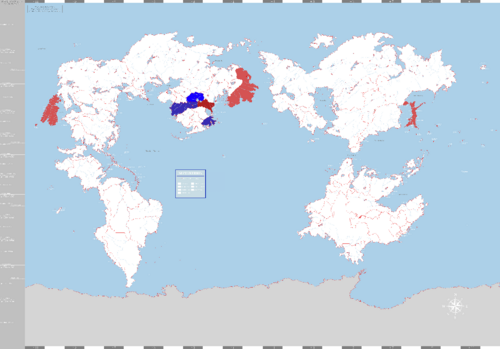War Plan Pančevo
This article is incomplete because it is pending further input from participants, or it is a work-in-progress by one author. Please comment on this article's talk page to share your input, comments and questions. Note: To contribute to this article, you may need to seek help from the author(s) of this page. |
War Plan Pančevo (a.k.a Operation Endgame) was a proposed full scale invasion of the Federal Republic of Ostland. The plan was highly controversial, and was removed from service in the 1970s. The plan was intended to be one of the most violent campaigns in history, outlining the use of all forms of weapons of mass destruction to force a "24 Hour Surrender". Its declassifiaction would lead to the War Plan Scandal
| War Plan Pančevo | |||||||
|---|---|---|---|---|---|---|---|
| Part of Sebrenskiyan-Ostlandic Border Crisis | |||||||
 | |||||||
| |||||||
| Belligerents | |||||||
|
Potential assistance from |
Potential assistance from | ||||||
War Plan Pančevo was developed by Defense Minister Slavko Marić in response to a series of conflicts with the Federal Republic of Ostland since the mid 1950s. The intention for the plan was to solve the border dispute once and for all, and permanently cripple Ostland to a state to where it could never be a challenger to any nation in the world again. There were 8 others involved in the production of the plan, but the plan never left the circle of 9 until it was discovered by Defense Minister Dragutin Košar in 1970.
The war plan outlined actions that would be needed to inflict catastrophic casualties, ruin Ostland's industry, and completely eliminate its entire armed forces in mere hours. If performed, it was estimated to have caused more casualties in any single event in human history.
History
Tensions with the two nations span as far back as recorded history, with Slavic tribes fighting with Eisen tribes. Sebrenskiya as a political entity, and Maldania during its independent period, repeatedly fought Ostlandic tribes, harassing the smaller states through most of their time. Hatred towards Sebrenskiya was fierce enough that shortly after Ostland's unification, Ostland promptly invaded Sebrenskiya. Sebrenskiya's defeat there led to political fear that Ostland would one day return to fight. Though Ostland did not invade during the Pan-Septentrion War, Sebrenskiya did join the conflict and defeated Ostland. Regional fears that a strengthened Ostland would return to fight the continent again were felt to have been ignored by the allied occupation forces.
In 1954, Sebrenskiya reneged on a Pan-Septentrion War treaty, neglecting to return the control of waterways on the border with Ostland to a join control. Concerns that Ostland would remilitarize and invade Sebrenskiya over the matter forced militarization by Sebrenskiya, forcing Ostland to militarize as well. In Sebrenskiya, the conflict was viewed as proof that Ostland needed to be fully quelled, and various government agencies placed on the table full invasion through the 1950s and 1960s, but War Plan Pančevo was the only conflict that was not intended to by hypothetical.
Outline
War Plan Pančevo first described military resources, major population centers, transportation lines, and water resources, in order to plan strikes with thousands of munitions of various kinds. It then detailed how to protect itself from retaliation from Hallia and Dayashina, as well as prevent the backlash of weapons used against Ostland.
Phase One
Phase One was considered to be the most brutal part of the plan by commentators and Minister Košar, and it was the reason for the removal of the plan.
Phase one consisted of nuclear, chemical, biological, and radiological strikes against any target of military value, industry, transportation, or major population centers of greater than 10,000 inhabitants. Nuclear strikes would be focused on centers of national governance, major military installations, transportation hubs, and any high-density population city. Chemical strikes would heavily attack civilian population centers, with the intentions of "killing or permanently incapacitating 80% of the population in strike zones". Biological weapons were specifically intended to target hospitals and areas with a high elderly population, in order to inflict the most casualties possible. In addition to that, they would also be used to target water supplies, in order to keep the viral infections into systems, as well as destroy large amounts of crops within Ostland. Radiological strikes would be used against smaller military installations, those which did not warrant massive explosions but still intended to keep them unoccupied as long as humanly possible.
This series of attack was designed to destroy "80% of Ostlandic military capability", kill "60% of the population", and cripple the government to where it could not effectively coordinate any resistance efforts of any kind.
Phase Two
After strikes massively incapacitated any Ostlandic response, the plan called for 800,000 invasion troops in the event that Ostland did not immediately surrender. They would secure ruins of Krossa and Mjors, and the secure coastal cities for potential retaliations. If then Ostland did not surrender, it called for the mass execution of all survivors who worked for any government agency within Ostland and their families.
Ostland's plans for Sebrenskiyan Invasion
Internal Reactions
Defense Minister Dragutin Košar found the plans in 1970, and wrote in various notes that the plan was "disgusting" and "heartless". Upon decommissioning the plan, Košar ordered the covert execution of anyone involved in creating the plan.
The plan was declassified in 2014, and despite no fanfare from the government, the Yugoslovenski Federal Times reported on the declassified war plan, causing major anger within the civilian population. Prime Minister Valentin Perko declared the plans a "demented outlier", and that the plans did not indicated any specific wish by the Sebrenskiyan government to "massacre millions of innocent people."
Perko then pressed charges against Slavko Marić for "conspiracy to commit genocide" through the Sebrenskiyan military, but Slavko Marić committed suicide during the trial by attacking a Military Police Officer.